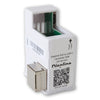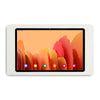The reason why people visit a clinic is always the same: patients require medical care, usually involving surgical procedures. Following the operation, several days of hospitalization with nursing care are usually necessary. During their stay, patients want to feel comfortable and also expect the best possible healthcare, both during the surgery and in post-operative care. To ensure that surgeries and other clinical procedures run as smoothly as possible, digitalization in hospitals is an essential measure. In addition to the electronic backup of documents and patient records, it is also important to utilise technologies for the automation of workflows and processes. Therefore, the concept of the ‘smart hospital’ is playing an increasingly important part in the realisation of digital hospital operations. But what exactly does this model entail? In the following article, find out what a Smart Hospital is, why it is necessary, and how smart devices are used in Hospital 4.0.
Definition: What is a smart hospital?
Digitalization and the use of technology are occurring in all areas of social and economic life. Tablets and smartphones are our constant companions, private homes are being equipped with smart systems, and AI-based robots are increasingly used in industries and the production of goods. Therefore, it is not surprising that also clinics are continuously becoming more digital, transitioning into ‘Smart Hospitals’. But what does this mean?
- The term refers to a hospital infrastructure that uses digital documents, comprehensive software solutions, and interconnected equipment and networking workflows.
- The intelligent infrastructure of a smart hospital typically features AI-based technology, high-performance Wi-Fi networks, and cloud systems.
- Tablets equipped with comprehensive or targeted apps are being utilised increasingly.
Background: Why is there a need for a smart hospital?
The world we live in is characterised by continuous changes, rapid developments, and unpredictable crises. Key concepts such as increasing efficiency, competitiveness, and sustainability are also top priorities within the healthcare sector. Given the current situation in hospitals, meeting these requirements has become their daily challenge. The necessity for digital support systems is growing steadily. The following reasons highlight why the digital transformation in hospitals towards a smart healthcare system is essential:
- Shortage of skilled professionals
- Demographic changes
- Sustainability measures and strategies (e.g., energy reduction)
- Cost reduction
- Patient satisfaction
- Resource utilisation
- Data management
Objectives: What drives the realisation of a smart hospital?
The list of backgrounds also raises the question of which intentions are associated with implementing a smart hospital. The following goals are linked to the Smart Hospital concept:
- Improvement of Patient Care: By working with smart technology, patients can receive more accurate diagnoses, helping them feel reassured and well advised. The use of AI-powered diagnostic tools, connected medical devices, and personalised treatment approaches ensures, that care becomes faster and more precise. Telemedicine allows consultations between patients and clinicians to take place on screen. The transition to a smart exchange of information elevates communication to a modern level, in line with the vision of a Clinic 4.0.
- Relief for Nursing Staff: The growing shortage of nursing professionals presents a significant challenge. Smart Hospitals focus on automated processes and digital assistance systems to take administrative duties away from nursing staff. Routine tasks such as monitoring vital signs or handing out medication can be digitally supported, allowing nurses to reallocate their resources and spend more time directly caring for patients.
- Support for Doctors: Physicians also benefit from the innovative shift forward to a smart hospital. AI-based analyses and big data technologies can evaluate medical data and lab results more quickly, providing doctors with a reliable basis for decisions. This shortens the time needed for diagnoses and enables more targeted treatments. Additionally, automated documentation processes in a smart hospital reduce bureaucratic tasks, freeing up more time for patient care.
- Reduction of Expenses: Another goal of the modern hospital is to enhance efficiency through the use of networked technologies. Automated processes, such as digital patient data management, AI-powered diagnostic tools, and robotic surgeries, lower effort and error rates. Improved workflows enable faster and more precise care, leading to shorter hospital stays and, consequently, reduces running costs.
- Contribution to Sustainability: The transition to Hospital 4.0 promotes sustainability within the healthcare sector. Furthermore, the automation of multiple processes and the use of energy-efficient technologies, such as intelligent lighting systems and eco-friendly cooling systems, significantly reduce the hospital’s energy consumption. In addition, the decreased use of paper through electronic patient records conserves resources. Over the long term, Smart health clinics help to minimise the ecological footprint.
Application: Where are smart devices used in a modern hospital?
For a targeted and efficient transition towards a Smart Hospital, it is essential for healthcare facilities to work with versatile and intuitive devices. It makes sense to use tablets for centralised data backup and direct communication. The following use cases illustrate how tablets can be used within a connected hospital:
One possibility is to install tablets in patient rooms. For patients who are hospitalised for several days, these devices can be particularly beneficial in the following ways:
- Communication with Nursing Staff: Patients can directly contact nursing staff digitally.
- Information: Patients in a Smart Hospital can use tablets to communicate with doctors, ask questions, or participate in telemedicine consultations. Patients also receive information about their medical condition, treatments and medication in an interactive way.
- Multimedia Entertainment: Tablets provide access to entertainment options (e.g., movies, games) and enable contact with family members. Using headphones, patients can enjoy these services without disturbing other patients.
Moreover, working with tablets also represents a valuable addition for nursing staff in a connected hospital.
- Digital Documentation: Tablets simplify the mobile recording of patient data, vital signs, and care reports directly at the bedside.
- Medication Management: Nursing staff can use tablets to ensure the correct medication is administered at the right time.
- Task Management: Tablets help nursing staff to plan, prioritise, and coordinate tasks efficiently with other team members.
- Inventory Management: Smart systems enable real-time inventory tracking. Supplies can be managed digitally, ranging from simple plasters and surgical instruments to blood units.
Finally, the integration of tablets in the operating room provides a valuable enhancement for surgeons, anaesthetists, and surgical assistants:
- Access to Patient Records: Doctors can access all patient data and medical records via tablets at any time, enabling more informed decision-making. Comprehensive patient data is especially critical when administering anaesthetics.
- Imaging and Diagnostics: Tablets allow doctors to view and analyse X-ray images, MRI scans, and other diagnostic data on the go. Algorithms further simplify the interpretation of these images.
- Teleconsultation: Doctors can use tablets to communicate with specialists outside the hospital in real time, enabling collaborative diagnosis discussions.

Installation: Securely installing smart devices with solid wall mounts
Once a clinic has decided to transform towards a Smart Hospital system and undertake the associated building digitalization, the next step is to integrate smart devices, such as tablets, into the hospital infrastructure in a way that is both stable and practical.
- Benefit from robust wall mounts by Displine, such as the Companion Wall 2.0 for iPads or the Companion Wall 2.0 for Samsung devices.
- These wall mounts can be attached to movable arms. In both patient rooms such as operating theatres, tablets can be pulled closer on the adjustable mounts when needed. When not in use, the movable arm can simply be pushed aside.
- The mounts are made of durable aluminium, providing a solid framework for tablets or iPads. Furthermore, the aluminium surface is highly resistant, making it easy to disinfect with cleaning agents.
- Depending on your requirements, the wall mounts can be installed in either portrait or landscape orientation.
- The wall mounts allow a constant connection to a power source, enabling you to charge your tablet permanently. This ensures that they are always ready to use.
- An integrated theft protection mechanism ensures that the tablets and iPads remain securely in place and cannot be removed by unauthorised individuals.








Leave a comment
This site is protected by hCaptcha and the hCaptcha Privacy Policy and Terms of Service apply.